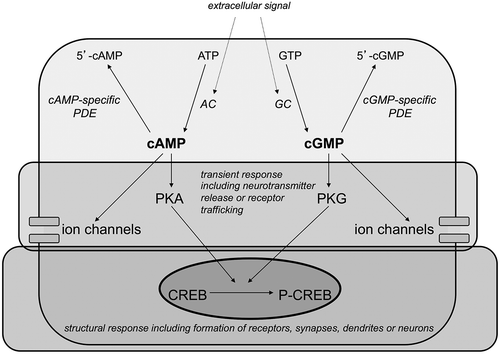Figures & data
Figure 1. Overview of the specificity of PDE1 to PDE11 for cAMP and/or cGMP. Reproduced with permission from [Citation5].
![Figure 1. Overview of the specificity of PDE1 to PDE11 for cAMP and/or cGMP. Reproduced with permission from [Citation5].](/cms/asset/fa455760-25e3-4571-8fa6-68c8db297e2a/ieid_a_1364360_f0001_oc.jpg)
Figure 2. Mechanism of action of PDE inhibitors. An extracellular signal (e.g. neurotransmitter or hormone) activates adenylate cyclase (AC) and guanylate cyclase (GC), which produce their corresponding cyclic nucleotides out of ATP and GTP, respectively. cAMP activates protein kinase A (PKA) and cGMP activates protein kinase G (PKG). Both PKA and PKG can phosphorylate other enzymes or transcription factors such as CREB in the nucleus. Besides gene expression, cAMP and cGMP also regulate cAMP- and cGMP-gated ion channels, respectively, which depolarize the synaptic terminals. Eventually, these processes will result in a cellular response, e.g. neurotransmitter release, receptor trafficking, synapse formation, dendritic formation or neurogenesis. Phosphodiesterases (PDEs) hydrolyze cAMP and/or cGMP leading to the formation of the inactive 5ʹ-cAMP and 5ʹ-cGMP, respectively. PDE inhibitors are selective for cAMP and/or cGMP degrading PDEs, and thus can specifically influence the cellular response of a biological system, in this case brain circuitry implicated in cognitive processes and neuroprotection.

Table 1. Overview of the changes in mRNA expression levels per subtype of PDE (gene product if known) in the hippocampus/temporal cortex of AD patients.
Table 2. Overview of clinical studies on the effects of different PDE inhibitors on cognitive (memory) performance in adults, elderly, and patients with MCI or AD.
